You’ve built your website and want it to stand out, be memorable, attract a large number of interested visitors — and not get lost in the vastness of the internet.
But how do you draw attention to it and present yourself as a useful, trustworthy, and engaging resource? The answer is simple: through dofollow links.
Why are these links so important? Because they don’t just bring visitors to your site. They also send strong signals to search engines to take notice of you. Every dofollow link passes on a certain strength — what SEOs call "link juice" — that boosts your page’s ranking in search results. It’s like a vote of confidence from other websites: they’re recommending you, and search engines begin to view your resource as more valuable and authoritative.
It’s crucial that the links are high-quality. Imagine getting recommendations from friends who are experts in the topic — that’s far more valuable than advice from random strangers. Links from authoritative and relevant sites can truly take your website to the next level and establish it as a trustworthy source.
Dofollow links can be the key to increasing organic traffic to your site, because they work not only for search engines but also for real users. People who click on such links often become your new visitors — and customers. That means every high-quality link is a chance for your content to be discovered.
In this blog, we’ll break down why do follow links are essential for SEO, how they help improve your rankings, and how to use them effectively to get the best results. Don’t miss the opportunity to make your website more visible online and help it reach its audience among countless other resources!
Why Getting High-Quality Links Matters
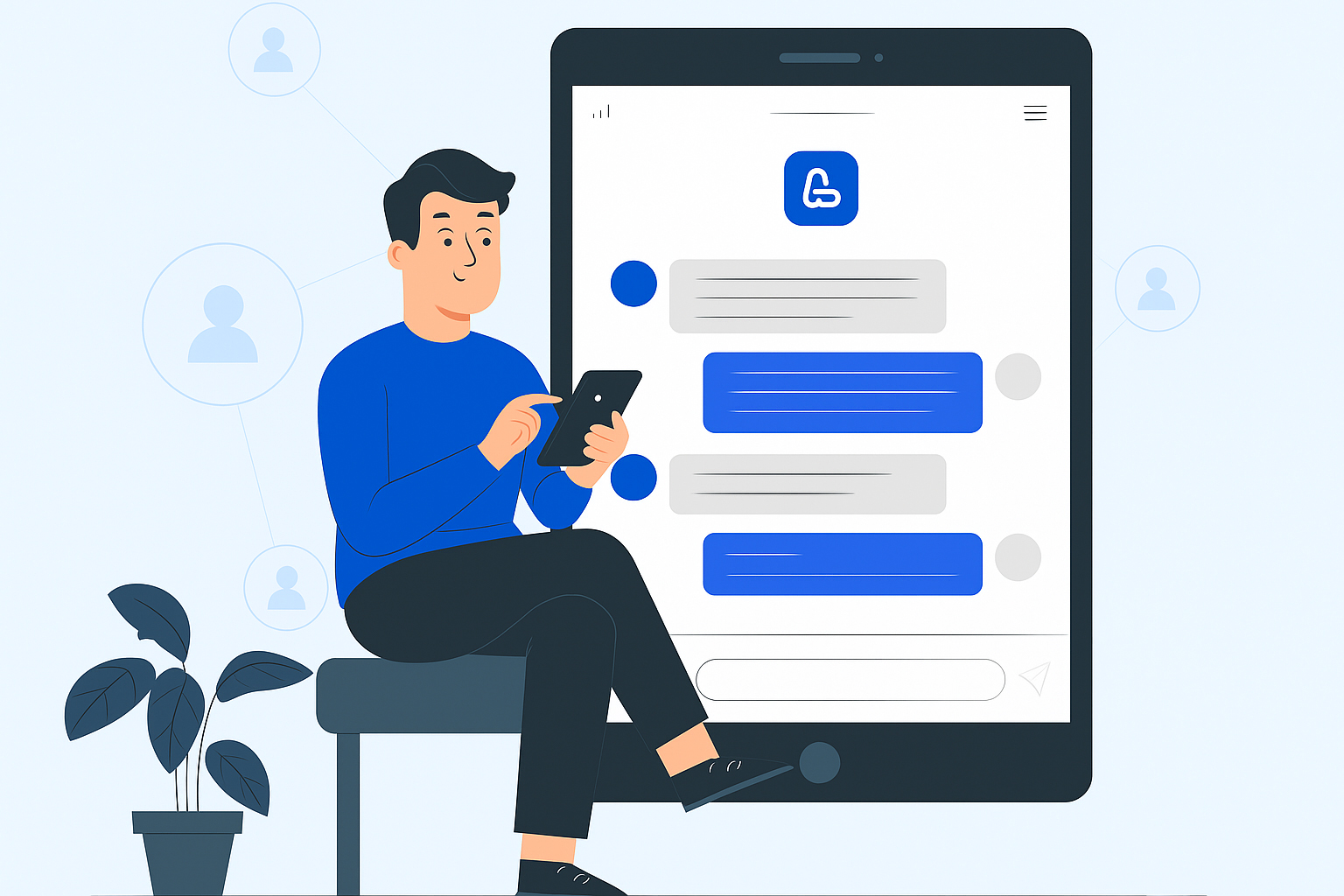
In today’s digital landscape, the best dofollow links are more than just navigation elements — they’re symbols of trust. The internet is a vast space filled with countless websites, where each link serves as a kind of recommendation from one resource to another. The more authoritative the site that gives this recommendation, the more valuable it becomes. So, what are the key advantages?
- Search Engine Trust
Search engine algorithms prioritize quality. When reputable websites link to yours, it's like getting a recommendation from a recognized expert. Search engines interpret this as a signal: “This site is trustworthy.” As a result, your resource climbs higher in the rankings and becomes more visible to your target audience. - Targeted Traffic
High-quality links don’t just bring visitors — they attract potential customers. When a niche-relevant site links to your article or service, the people who arrive are already interested in your topic. It works like a powerful magnet drawing in exactly those users who are ready to engage with your offering. - Brand Reputation
When your site is mentioned on respected platforms, it instantly boosts your brand image. Being associated with thought leaders and authoritative sources creates a halo of professionalism. Even before visiting your site, users start to see you as an expert in your field. - Protection from Algorithm Changes
A solid link-building strategy is like insurance against the unpredictability of search engine algorithms. While low-quality (poorly planned) link strategies can collapse after every update, natural, well-earned links continue working in your favor regardless of algorithmic changes.
By investing time and resources into acquiring high-quality backlinks, you’re building not just short-term success but a lasting foundation for your digital presence. It’s not about instant results — it’s about gradually shaping your authority and reaping measurable benefits over time.
What Are Dofollow Links?
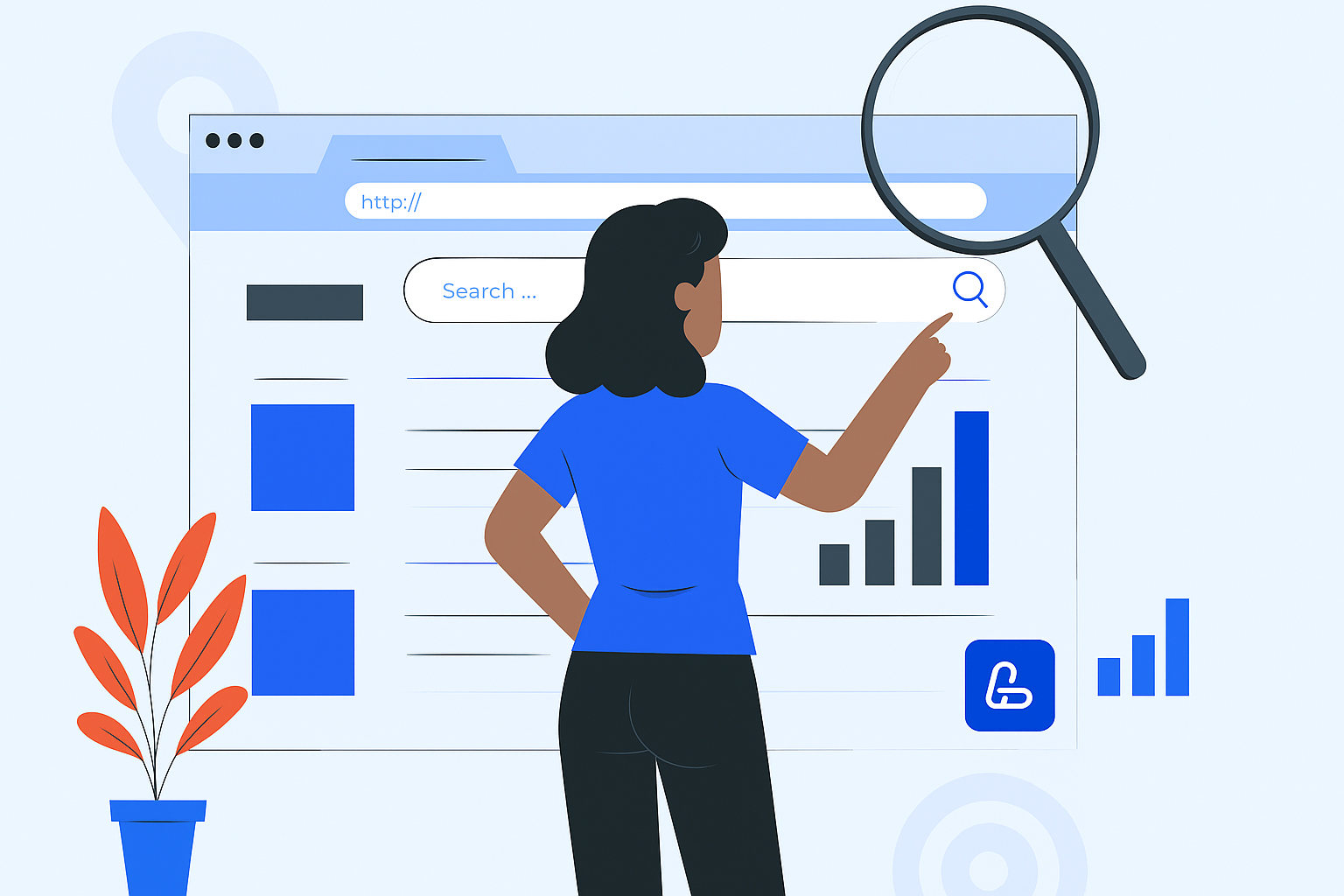
Dofollow links are hyperlinks that allow search engines to follow them and consider them when evaluating the quality, relevance, and authority of the target page. These links pass link equity, directly influencing the ranking of that page in search engine results.
Search bots discovering dofollow links doesn’t automatically validate a website’s authority, but high-quality links can positively affect how it’s perceived by ranking algorithms. This, in turn, helps improve the site’s visibility in search results.
Links with the dofollow attribute are actively used to build a site’s backlink profile and enhance its SEO performance. The more high-quality dofollow links point to your site, the better its chances of ranking higher.
It’s important to understand where to place a dofollow link to achieve the best results. That’s why these links should be published on authoritative and relevant platforms — which further amplifies their positive impact on your rankings.
Description and How It Works
The way dofollow links work is fairly straightforward: when one website links to another, search engines interpret it as a recommendation.
A dofollow link in HTML looks just like a regular hyperlink. Here’s what dofollow link code in HTML looks like:
<a href="https://example.com">link text</a>
In this example, the link is dofollow because the <a> tag does not include the rel="nofollow" attribute. This means that search engines will count this link when evaluating the authority of the linked website.

Search bots take into account the quality and relevance of the sites where these links are placed — the more authoritative and trusted the referring site is, the more impact the link will have on promoting the target resource.
Dofollow links act as validation that the content on the target page is important and useful for users. If your site receives many high-quality and relevant dofollow links, this significantly improves its visibility in search engines and strengthens its rankings.
Search engines treat these links as one of the key factors in assessing the value of content. Web pages that receive such links are more likely to rank higher in search results.
An important part of how dofollow links work is context. A link placed on a website that is closely related to your content’s topic will be far more effective than a link from a site that has nothing to do with your niche.
For example, if your site is about healthy eating, a link from a recipe blog will carry much more weight than a link from a site discussing financial news. The contextual relevance of the link plays a key role in search ranking.
Dofollow links are an essential part of any link-building strategy. They not only help improve your site’s rankings in search engines but also bring in targeted visitors. Skilled link builders use these links as efficiently as possible, focusing on their quality, topical relevance, and the authority of the referring sources.
A well-structured strategy for building a strong backlink profile will ultimately become the foundation for successfully promoting your site and increasing its visibility online.
What Are DA and DR
Two of the most popular and widely used SEO metrics are Domain Authority (DA) and Domain Rating (DR).
What is DA (Domain Authority)?
Domain Authority (DA) is a metric developed by Moz that evaluates a domain’s ability to rank high in search engine results. DA takes into account over 40 factors, including the number and quality of backlinks, domain age, site structure, and other elements. The higher the DA score, the more likely it is that the site will rank well and be indexed effectively by search engines.
DA scores range from 1 to 100. A domain with a score of 100 represents an ideal site with high trust and authority in search engines. Conversely, a site with a low DA may struggle to achieve good rankings — especially in competitive niches.
What is DR (Domain Rating)?
Domain Rating (DR) is a similar metric to DA, but developed by Ahrefs. It measures a domain’s strength based on the quality and quantity of external backlinks pointing to it. DR focuses specifically on how many links a domain gets from high-authority websites. Unlike DA, which takes a broader range of ranking factors into account, DR is strictly link-based.
Like DA, DR is measured on a scale from 1 to 100. Websites with high DR scores typically have a large number of quality backlinks and are considered authoritative by search engines.
How Are DA and DR Related?
Although DA and DR serve similar purposes — evaluating domain authority and ranking potential — they are calculated differently and often produce different results. DA, developed by Moz, considers both internal and external factors, while DR, from Ahrefs, focuses purely on external link signals.
For SEO professionals, it’s important to understand that both metrics are useful when analyzing link-building strategies. For instance, working with websites that have high DA and DR scores is essential for successful outreach, since they pass value through high-quality dofollow links, helping boost rankings in search results.
Dofollow vs. Nofollow Links: Their Impact on DA and DR
SEO specialists must understand not only how DA and DR relate to domain rating, but also how link types — dofollow and nofollow — influence these metrics.
- Dofollow links pass authority and link equity from one site to another. When your site earns a dofollow backlink from another domain, search engines take that into account when calculating both DA and DR.
The more high-authority dofollow links you earn, the greater the chances your site will achieve higher rankings. These links carry real SEO weight and can significantly improve your domain’s performance in search. - Nofollow links do not pass authority and do not directly impact a site’s DA or DR. While search engines typically do not consider them for link equity, nofollow links still play a role in an effective link-building strategy.
Nofollow links can indirectly affect rankings by driving traffic and increasing brand awareness. However, they don’t contribute to the strength of your backlink profile in the eyes of search engines.
How DA and DR Influence SEO
Both DA and DR are used to assess a domain’s authority and its ability to compete in search results. They play an important role in link-building strategies and shaping a strong backlink profile.
As you work on promoting your website, it’s important to consider both dofollow and nofollow links.
The most effective link-building strategies combine a mix of dofollow and nofollow links to achieve maximum impact.
When to Use a Dofollow Link
Dofollow links should be used when you want to:
- Pass trust and value to another resource
If you’re linking to an authoritative, trustworthy, and relevant site that you genuinely endorse — feel free to use a dofollow link. This tells search engines that you’re sharing a useful and verified source, not hiding it. - Strengthen a website’s SEO profile
When building a backlink profile for your own project or a client’s, it’s important to aim for high-quality dofollow links. They transfer link equity and help the site grow in search rankings. - Connect internal pages of your website
Internal linking with dofollow helps search engine crawlers understand your site’s structure and distributes link equity across important pages. It’s beneficial for both SEO and user experience. - Recommend partners or clients
If you're linking to a partner, client, or any site with which you have a professional relationship, a dofollow link strengthens trust and demonstrates transparency.
Although a dofollow link passes authority from one page to another and influences SEO rankings, there are cases when using dofollow is not recommended:
- Advertising and affiliate links
If the link leads to an ad or affiliate resource, it's better to use the nofollow attribute to avoid passing link equity to a site with which you don't have a mutual relationship. Using dofollow on such links may be seen as a violation of search engine guidelines. - Links in comments or forums
Users often leave spammy comments on forums. In such cases, use nofollow to prevent passing authority to external sites — especially when the content is user-generated and not trusted. - Internal links to duplicate content
If your site contains pages with duplicate content (e.g., accessible through different URLs), these should be connected with nofollow links to avoid passing link equity to pages that might negatively impact SEO. - When the content is sponsored
If the page contains paid content or a press release, it should not be linked using a dofollow tag, as this can be seen as an attempt to manipulate search rankings. In these cases, always use nofollow. - Excessive linking on a single page
If a page has too many outbound links, use nofollow for some of them to avoid passing excessive link equity to external resources. This helps prioritize which links receive attention from search engines. - When managing your link profile
Overusing dofollow links or placing them on unmoderated pages can lead to an inflated and unnatural backlink profile. This may trigger spam filters and hurt your SEO in the long run.
What Is a Nofollow Link?
Nofollow links are hyperlinks with an added HTML attribute: rel="nofollow". This attribute tells search engine crawlers not to pass "link juice" or authority from the referring page to the target. Technically, a nofollow link looks like this:
<a href="https://example.com" rel="nofollow">Link text</a>

The History Behind It
The nofollow attribute was introduced by Google in 2005 as a solution to blog comment spam. Spammers would flood comment sections with links to manipulate search rankings. The nofollow tag gave site owners a way to signal that they don’t “endorse” user-generated links.
In 2019, Google expanded the rel attribute family by adding rel="sponsored" for paid links and rel="ugc" for user-generated content — allowing webmasters to classify links more precisely.
Why Was This Link Differentiation Necessary?
Since Google aims to guide users toward high-quality and relevant content, this additional classification helps search crawlers better understand and categorize links.
Why Is Content Understanding So Important?
Websites link to other content for various reasons:
- To direct users to a valuable resource on another site
- To mark affiliate links for sales tracking
- To identify original sources of information
- To encourage users to visit other posts within the same site
Can You Use Multiple Attributes Like nofollow, sponsored, and UGC Together?
Yes. If you're unsure which attribute applies, you can combine them. For example, a sponsored link posted on a forum can be marked as rel="ugc sponsored". However, paid links must include either “nofollow” or “sponsored” (or both), but not just “UGC.”
In Practice, nofollow Links Are Used in These Cases:
- User-generated content: Comments, forums, guestbooks, and other areas where users can insert links
- Paid content: Google recommends marking all sponsored or paid links with
rel="nofollow"(orrel="sponsored") - Unverified content: Links to sources the site owner doesn’t fully trust
- Login and registration pages: Links that don’t need to be indexed
- Widgets and tools: Embedded elements that may include links to third-party resources
When Not to Use nofollow Links:
- Don’t use it for links to your social media profiles.
- Don’t use it as a substitute for stopping indexing — use
noindexinstead.
How Are Nofollow Links Useful?
- They contribute to a natural and diverse backlink profile
- They can still drive real traffic, which indirectly benefits SEO
- Since 2019, Google treats the nofollow attribute as a “hint,” meaning it may consider such links for ranking in some cases
How Nofollow Links Affect SEO
Nofollow links are useful when you need to:
- Hide technical or utility links.
To save crawl budget, nofollow is often used on login or registration page links. - Avoid passing value to paid links.
Google considers paid links intended to manipulate rankings a violation of its guidelines. Marking them as nofollow prevents SEO penalties. - Prevent spam abuse.
Some CMS platforms automatically add nofollow to all comment links to discourage spam — users are less likely to drop promotional links if they don’t carry SEO value. - Avoid transferring link equity to third-party sites.
Many people try to insert their links into Wikipedia articles, but it’s ineffective — all external links there are marked nofollow, and only relevant ones get clicks.
Best Practices for Using Nofollow Links:
- The link's topic should be highly relevant to the page it appears on
- Use nofollow for ad or sponsored links to avoid passing PageRank
- Keep commercial anchor text links below 40% of your backlink profile
- In editorial content, use nofollow for external links unless they point to verified, authoritative sources
- Mark all user-submitted links in comments with nofollow
The Difference Between Dofollow and Nofollow Links
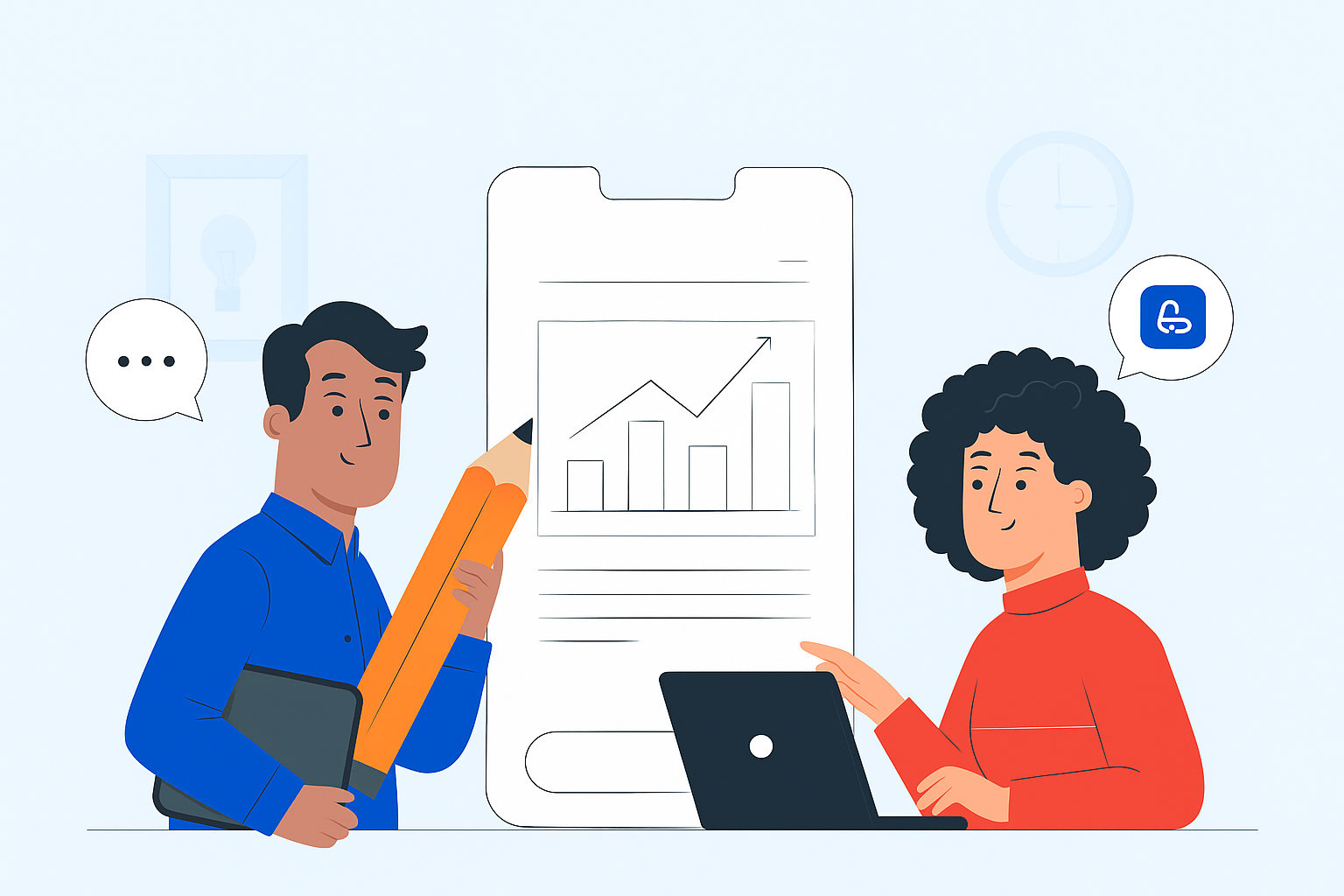
At first glance, dofollow and nofollow links may seem similar, but there are several key differences that play a crucial role in link building. So, what’s the difference between dofollow and nofollow, what do they have in common, and how do they impact SEO?
Here are the core functional distinctions between the two types of links:
- Link equity transfer: Dofollow links pass PageRank and authority, while nofollow links do not, meaning they don’t contribute to the site’s overall link profile.
- Impact on rankings: Dofollow links positively influence a website’s position in search results by boosting its authority and relevance, whereas nofollow links don’t have a direct effect on rankings.
- Indexing and crawling: Search engine bots follow dofollow links to index and analyze target pages, while they typically ignore nofollow links.
- Traffic generation: Dofollow links can directly bring users to a site, generating referral traffic, whereas nofollow links usually do not lead to direct visits.
- Reporting and analytics: Dofollow links show up in SEO and web analytics tools, providing valuable data to assess the effectiveness of a link-building campaign, while nofollow links play a less visible role.
Although nofollow links are traditionally believed to carry no link equity, they still hold strategic value in SEO. Underestimating them is a mistake — these links contribute to a diverse backlink profile, open doors to collaborations with authoritative sites, and can bring in qualified traffic to your website.
The Impact of Nofollow Links on Search Engine Rankings
For a long time, the SEO community believed that nofollow links didn’t pass any value and that dofollow links were the only ranking drivers. However, a study by Ahrefs revealed a more nuanced reality.
What the Ahrefs Study Found
The research significantly challenged the conventional wisdom about nofollow link influence:
- Source authority matters: Nofollow links from high-authority websites can affect rankings — though not as strongly as dofollow links.
- Quality still trumps quantity: A large number of nofollow links from low-quality sites has little to no effect on search visibility.
- Link-rank correlation: Analysis showed a consistent correlation between backlinks (including certain types of nofollow) and higher Google rankings.
Practical Takeaways for Link Building
In light of this data, a more balanced link strategy is essential:
For dofollow links:
- They remain a key ranking factor
- Quality is still more important than quantity
For nofollow links:
- They can indirectly influence rankings, especially when placed on authoritative sites
- They signal online activity and engagement to search engines
- They help create a natural, diversified backlink profile
Instead of saying, “nofollow links are useless for SEO,” it’s more accurate to say: “Nofollow links from trusted sources can positively affect rankings, though to a lesser extent than dofollow links.”
The Ahrefs study supports the fact that modern search engine algorithms are becoming increasingly sophisticated. They now evaluate a broader set of factors when determining a site’s authority and relevance.
That’s why it’s important to keep these subtleties in mind when building a well-rounded backlink profile — one that helps boost your site’s rankings and drive more targeted traffic.
Comparison of Dofollow and Nofollow Links
| Feature | Dofollow | Nofollow |
|---|---|---|
| Link equity transfer | Passes link juice and authority | Does not pass link juice |
| HTML attribute | No special attribute (default format) | Contains rel="nofollow" attribute |
| Indexing by search engines | Search engines follow and count the link for ranking | May be crawled but typically not counted for rankings |
| SEO impact | Strong — helps improve website rankings | Minimal — usually doesn’t affect SEO directly |
| Typical usage | Editorial content, trusted sources, internal linking | User comments, ads and sponsored content, social media widgets |
| Traffic generation | Can drive consistent referral traffic | Can increase brand awareness |
| User visibility | Visually identical to nofollow links | Visually identical to dofollow links |
| Additional attributes | None | May include rel="sponsored" or rel="ugc" |
However, according to Semrush's study and Ahrefs' research, nofollow links may still influence rankings in certain cases.
Why Are Dofollow Links Important for SEO?

As we've seen, in the world of digital marketing and SEO, dofollow links are a cornerstone of successful website promotion. These links serve as a powerful tool to boost your site’s visibility and competitiveness in search engine results.
A dofollow link from an authoritative and thematically relevant website is a foundation for effective link-building and brings a host of SEO benefits.
Authority and Ranking Boost
When search engines analyze web pages, they place particular emphasis on trusted links. The concept behind this mechanism is closely related to Google’s original PageRank algorithm. While today’s ranking algorithms are far more complex, the core principle remains the same:
- Every website has a certain level of authority (Domain Authority, Trust Flow, Domain Rating — depending on the tool used)
- Dofollow links pass a portion of that authority — the linking site shares some of its “value” with the linked page
- The amount of authority passed depends on several factors:
- The linking page’s own authority
- Topical relevance between the two sites
- The link’s placement on the page
- The number of other outbound links on the page (more links = less value per link)
- The anchor text and how natural it is
- The age and stability of the link
What Happens Technically
When a search engine bot encounters a dofollow link, it:
- Follows the link to the target page
- Registers the relationship between the two pages in its index
- Factors that link into the target page’s authority metrics
- Adjusts potential search rankings based on the accumulated link data
Cumulative Effect of the Link Profile:
- The impact builds over time — a single high-quality dofollow link rarely produces noticeable results on its own, but a consistent link-building effort leads to substantial authority growth
- “The rich get richer” principle applies — as your site’s authority grows, your outbound links carry more weight, and inbound links to your site become more valuable
- There’s a clear correlation between link profile quality and search rankings — research consistently shows that top-ranking pages in competitive SERPs usually have stronger backlink profiles
Practical Outcomes of Growing Authority
When a site’s authority increases through high-quality dofollow links:
- New content is indexed faster — search bots crawl authoritative sites more frequently
- Trust in the domain improves overall — the authority boost affects all pages on the site
- Higher visibility for competitive keywords — domain authority plays a key role in tough verticals
- Greater resilience to algorithm updates — strong natural authority serves as a safety net
- Increased likelihood of earning SERP features — such as featured snippets, carousels, and answer boxes
Improving Search Engine Rankings
Improving your rankings is arguably the most desirable outcome of dofollow link building. But how exactly do these links affect search performance — and why are they still considered one of the most powerful tools in SEO?
Direct Impact on Ranking Algorithms
Despite ongoing algorithm updates, high-quality inbound links remain a key ranking signal:
- Links as a foundation of relevance scoring — historically, Google’s success came from analyzing links as indicators of a page’s value and importance
- Confirmation from official sources — Google representatives have repeatedly stated that backlinks remain among the top three ranking factors
- Consistent correlation in studies — major SEO firms (Backlinko, Ahrefs, Semrush) continue to show a strong relationship between backlink quality and SERP positions
Interaction With Other Ranking Signals
Dofollow links work best when combined with other SEO factors:
- High-quality content + links — together they create a powerful compound effect
- Technical optimization + links — helps fully capitalize on the link equity
- User behavior signals + links — strong engagement confirms to search engines that top rankings are justified
High-quality dofollow backlinks from trusted sources — when paired with broader SEO efforts — lead to stable improvements in visibility for your most important keywords.
Increasing Traffic and Attracting Users
Dofollow links are a valuable method for driving traffic and building an engaged audience. So, what are the key benefits of placing dofollow links?
- Direct Targeted Traffic
Dofollow links placed on popular, authoritative websites generate a steady stream of visitors to your site. This traffic has several distinct advantages:- High relevance: users coming from niche-relevant resources are already interested in your topic
- Greater engagement: these visitors tend to spend more time on your site and interact with more content
- Higher conversion potential: interested users are more likely to become customers or subscribers
- Expanding User Touchpoints
Every dofollow link isn’t just a technical SEO signal — it’s also a potential interaction point with your audience:- Multichannel presence — distributing links across various platforms allows you to reach different audience segments
- Natural integration — contextual links within relevant content are perceived as organic recommendations
- Cross-audience reach — access users from related niches through partner or third-party sites
- Bringing in New Audiences
Dofollow links trigger a multi-stage process of user acquisition:- Initial placement: a link on an authoritative site brings in the first wave of engaged users
- Secondary distribution: impressed users share your content on social media or their own websites
- Chain reaction: each new mention has the potential to attract more users
- Exponential growth: valuable content can turn this process into a self-sustaining cycle
- Long-Term, Sustainable Traffic
Unlike short-term ad campaigns, quality dofollow links provide lasting results:- Consistent traffic source: blog posts and articles with your links can remain relevant for years
- Compounding effect: over time, the number of links grows, resulting in a steady traffic flow
- Budget independence: once placed, quality links keep working without additional investment
- Resistance to algorithm updates: natural dofollow links are less vulnerable to search engine changes
- Strategic Brand Positioning
Well-placed dofollow links help establish your brand in key informational spaces:- Association with specific topics: repeated mentions in niche contexts create lasting brand associations
- Differentiation from competitors: a unique footprint of link placements shapes how users perceive your brand
- Expansion of semantic reach: links from diverse platforms attract users with varied search intents
- Filling information gaps: links tied to problem-solving content attract highly targeted audiences
- Synergy With Other Marketing Channels
Dofollow links amplify the impact of your broader marketing strategy:- Boost to organic search: users introduced to your brand via links are more likely to search for it directly
- Support for content marketing: strong content gains more exposure through natural linking
- Social media integration: users who arrive via links often follow your social accounts
- Compliments email marketing: new visitors help expand your subscriber base
- High-Quality Traffic Metrics
Traffic from dofollow links tends to yield superior engagement stats:- Increased time on site: interested users consume more content
- More pages per session: they explore deeper into your site
- Lower bounce rate: relevance reduces the chance of immediate exits
- Higher return visits: a positive first experience encourages users to come back
- More goal completions: engaged users are more likely to take action and convert
Boosting Brand Awareness
Although dofollow links are typically associated with technical SEO and search engine rankings, their role in building brand awareness is just as important — and often underestimated.
Here’s how they influence brand perception:
- Authority transfer — being featured on trusted platforms creates an associative link between their credibility and your brand
- Thematic association — your brand becomes tied to specific topics, industries, or challenges
- Social proof effect — repeated brand mentions across multiple sources reinforce its relevance and perceived importance
Strategies for Enhancing Brand Awareness Through Dofollow Links:
- Branded Anchors and Mentions
- Strategic use of brand name — including your company name directly in anchor text or close to it
- Branded keyword phrases — connecting certain terms and ideas with your brand identity
- Unique identifiers — creating recognizable elements (e.g., named methods, frameworks, proprietary terminology) associated with your brand
- Contextual Positioning
- Topical focus — prioritizing link placement within a specific niche to build strong associations with your area of expertise
- Emotional context — placing links in content that evokes the emotions you want tied to your brand
- Problem-solving narratives — featuring your brand as a solution to your audience’s real challenges
- Integration With PR Strategy
- Media mentions with links — working with digital publications to secure not just mentions, but high-quality dofollow backlinks
- Thought leadership — publishing expert commentary, interviews, and articles on influential industry platforms
- News-driven linking — creating newsworthy events or reports that naturally generate branded backlinks
Improving User Behavior Signals
Behavioral signals reflect how users interact with your website — and while dofollow links are mostly discussed in a technical context, they also significantly impact these engagement metrics. So how exactly do dofollow links improve behavioral factors, and why does it matter for holistic SEO?
Key Behavioral Metrics Improved by Dofollow Links
- Page Depth
- More pages viewed per session — high-quality referral traffic often explores more than just the landing page
- Clearer user pathways — visitors from thematically relevant sites navigate your structure more intuitively
- Stronger interest in related content — higher likelihood of clicking internal links and recommended articles
- Time on Page and Site
- Longer average visit duration — users arriving through niche-relevant links tend to stay longer
- Fewer shallow sessions — deeper engagement, fewer one-page visits
- Greater interaction with multimedia — increased likelihood of watching videos, viewing images, or exploring interactive content
- Conversion Behavior
- More micro-conversions — such as newsletter signups, resource downloads, or comments
- Higher macro-conversion rates — such as purchases, form submissions, or inquiries
- Lower cost per conversion — because more of your visitors are already engaged and motivated to act
By attracting qualified and interested visitors, dofollow links help improve behavioral metrics — which in turn sends positive signals to search engines and supports long-term SEO growth.
How to Check Dofollow and Nofollow Links
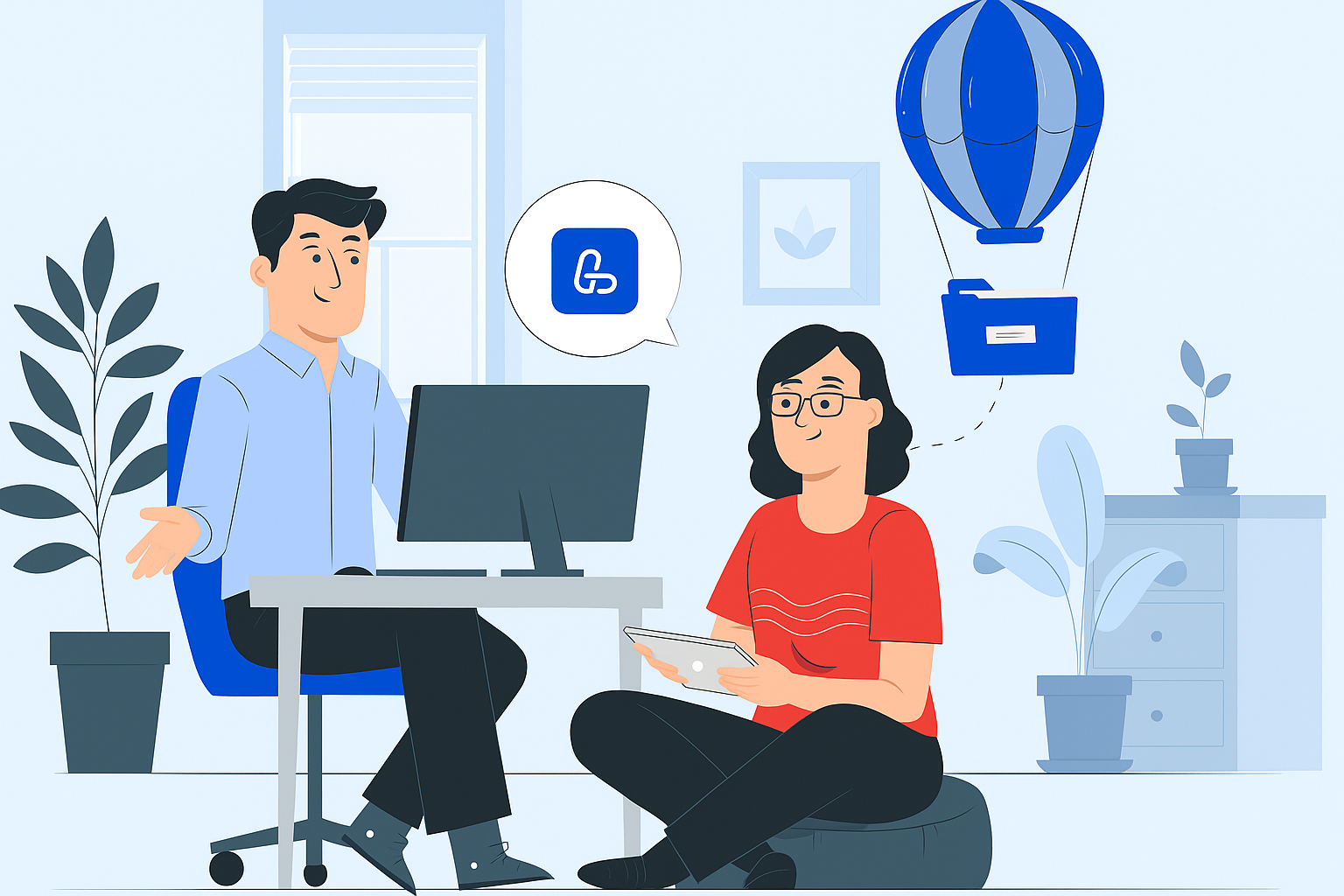
Understanding how to distinguish between these two link types is essential for effective SEO, as it helps avoid unwanted attention from search engines and allows you to fine-tune your link-building strategy.
To identify dofollow links, you can use site analysis tools or manually inspect pages that don’t include the rel="nofollow" attribute.
There are several ways to check link types — including browser developer tools, extensions, and online platforms that help detect link attributes quickly and efficiently.
1. Checking Links in Chrome Browser
In Google Chrome, you can easily inspect the source code of any link:
- Right-click on the link and choose “Inspect”
- A side panel will open showing the HTML code of the page, including the link’s tag
If the <a href> tag does not contain a rel attribute, then it’s a dofollow link by default.
Nofollow links will be explicitly marked with the attribute rel="nofollow".
2. Using Ahrefs Site Explorer
- Enter the domain name into the “Site Explorer” tool

- Go to the “Backlinks” report
- Click on “Referring Domains” to see all linking domains

- Use filters to sort the links by type: dofollow, nofollow, sponsored, or UGC
3. Checking Links With Semrush
- Type your domain into the “Domain Overview” section

- Go to the “Backlinks” section to see the total number of dofollow and nofollow links, and which pages they point to

- View percentage breakdowns of link types, including sponsored and UGC attributes

This gives you a complete overview of your site’s link profile and the distribution of different link types.
Using Nofollow and Dofollow Links Together
Considering everything outlined above, the optimal and safest strategy for link builders is to aim for a mix of both dofollow and nofollow backlinks. This balanced approach allows you to get the most out of nofollow links as well — just as Ahrefs research recommends — and it can be further strengthened by combining it with other link-building methods.
Recommendation: Aim to maintain a balanced backlink profile, ideally around 60% dofollow and 40% nofollow links. Alternatively, a 70/30 dofollow-to-nofollow ratio is also acceptable, as long as nofollow links remain within 30–40%.
To make the most of dofollow and nofollow links, follow these key principles:
1. Leverage the Strengths of Each Link Type
Dofollow and nofollow links are two sides of the same coin. While dofollow links are critical for improving rankings, nofollow links still provide important value — they drive traffic, boost brand visibility, and maintain a natural and diversified backlink profile.
Pro tip: Use dofollow links to build authority, and include nofollow links to expand traffic and visibility.
2. Be Strategic With Placement
To use both link types effectively, placement matters. For instance:
- Save dofollow links for authoritative websites in your niche
- Use nofollow links for newer or less trusted platforms like forums, directories, or social networks
This approach diversifies your backlink profile and helps capture referral traffic at the same time.
Pro tip: A few nofollow links from high-authority sites can drive more traffic than a large number of dofollow links from weak sources. Always prioritize quality over quantity.
3. Focus on Link Quality
Quantity isn’t everything — quality matters most. Focus on securing links from authoritative websites in your industry. A few strong dofollow backlinks from trusted sources will have more impact than dozens from low-quality domains.
The Semrush Ranking Factors 2.0 study emphasizes that direct visits from trusted sites strongly influence search rankings.
But traffic depends not just on link authority — visitor engagement also plays a key role. Users need to be motivated to click and interact with your content, so optimizing for engagement is essential.
4. Diversify Your Link Sources
A healthy backlink profile is a diverse one. Seek out both dofollow and nofollow opportunities across different platforms:
- Guest blogs
- Social media
- Online directories
- Industry forums
- Influencer collaborations
This variety strengthens your profile and broadens your audience reach.
5. Develop a Custom Link-Building Strategy
While dofollow links are undeniably essential, a successful link-building strategy should integrate nofollow links into various outreach efforts, such as:
- Guest Blogging
Publish valuable content on industry-relevant sites. Even if they only offer nofollow links, the exposure and authority are still beneficial. - Social Media
Share your content on social platforms. Nofollow links from these networks help amplify visibility, especially when you engage in conversations and comments. - Online Communities
Platforms like Reddit and Quora can still drive relevant traffic. Use them as supplemental sources, not your main strategy. - PR Links
Mentions from journalists and media sites — even nofollow — are valuable due to their credibility and reach. - Collaborations
Partner with influencers, bloggers, and businesses in your niche. These relationships often lead to a mix of both dofollow and nofollow links across content types.
By combining various link types and sources, you can create a robust and balanced link-building strategy — one that not only boosts your SEO but also attracts a loyal, engaged audience over the long term.
How to Get High-Quality Dofollow Links
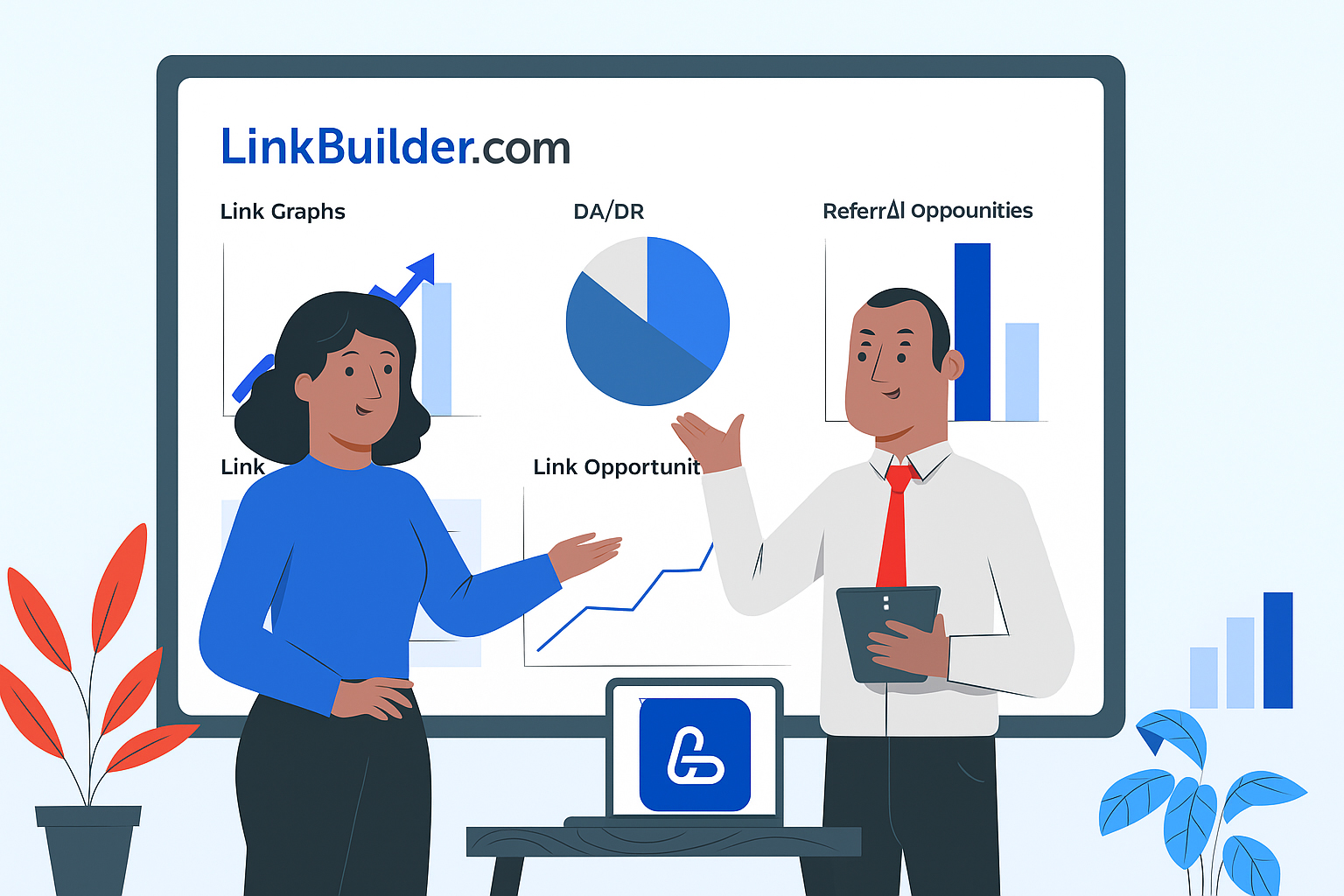
In today’s SEO landscape, acquiring high-quality dofollow backlinks requires strategic planning and consistent effort. Search engines have become much more adept at detecting artificial link schemes, and misuse can lead to penalties. That’s why natural, organic link building with dofollow links remains the preferred and safest approach. So, how can you get dofollow links?
Here are several effective methods for obtaining high-quality dofollow backlinks:
Guest Posting
Earning dofollow links through guest posts is one of the most effective and widely used strategies for boosting SEO and increasing site visibility. Guest posts are articles you write and publish on third-party blogs or websites in your industry, typically in exchange for a link back to your site.
What should you look for in guest post opportunities?
Not every site is suitable for guest posting. To ensure you’re building a strong backlink profile, evaluate sites based on these factors:
- Domain Authority: Look for websites with high Domain Authority (DA). The higher the DA, the more valuable a backlink from that site will be for your SEO.
- Topical Relevance: Prioritize blogs and websites that operate within your niche or industry. This ensures the backlink is contextually relevant and SEO-effective.
- Content Quality: Only publish on platforms that produce high-quality, original content. It enhances both search engine trust and user credibility.
- Audience Engagement: Sites with an active, engaged readership will drive more referral traffic than those with low user interaction.
How to find guest posting opportunities in your niche:
- Niche Research: Define your niche and audience. Understand the themes, trends, and interests that resonate in your industry.
- Competitor Analysis: Identify successful bloggers or content creators in your space. Check where they’ve published guest posts and reach out to those same sites.
- Google Alerts: Set up Google Alerts for relevant keywords in your niche to be notified about new guest posting opportunities.
- Social Media Monitoring: Follow influencers, bloggers, and niche websites on social platforms — they often share guest post opportunities.
Where to Look for Guest Post Opportunities:
- Google Search Operators: Use search queries like:
- keyword + “guest post”
- keyword + “write for us”
- keyword + “guest article”
- keyword + “sponsored post”
- keyword + “contribute”
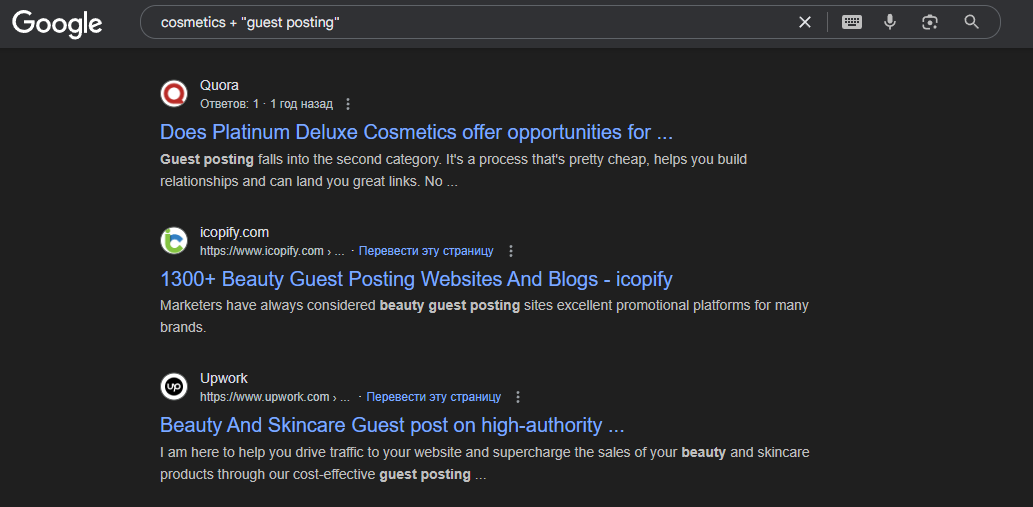
- Niche Communities: Join online forums, Facebook/LinkedIn groups, or Slack channels relevant to your industry. Engage with members and discover guest post opportunities they share.
- Content Aggregators: Explore websites that curate guest post opportunities by niche or category.
- Outreach: Contact bloggers and creators directly — many are open to collaborations or content exchanges.
- Guest Post Directories: Use dedicated directories or databases that list sites accepting guest contributions.
- Industry Publications: Look for trade magazines or niche publications that accept contributed articles from external authors.
By using these methods and targeting relevant, authoritative sites, you can earn valuable dofollow backlinks that support both your SEO goals and overall brand visibility.
To earn high-quality dofollow backlinks through guest posting, follow these steps:
- Target relevant websites: Focus on blogs or websites in your industry or niche that accept guest contributions and have high Domain Authority (DA) or Domain Rating (DR). These platforms are more likely to offer valuable dofollow links.
- Craft a compelling pitch: Your outreach message should be unique and stand out from the hundreds of guest post requests these sites receive monthly. Personalization and a clear value proposition are key.
- Provide high-quality content: To get your article accepted, you need to offer genuinely useful and well-written content. Websites won’t publish your post — or link back to you — if the material isn’t engaging or valuable to their audience.
- Include a dofollow link: Make sure your guest post contains a relevant dofollow backlink to your site. Most reputable blogs allow such links in guest content, but it’s always best to confirm this with the blog owner beforehand.

If you’re looking for quality platforms to publish guest posts, LinkBuilder.com’s guest posting service can help you find the right option. But if you prefer a DIY approach, the company also offers powerful tools like the Guest Post Selection Tool and Guest Post Scanner — designed to simplify the process of discovering link sources and comparing prices across blogs and marketplaces.
Building Resource Page Links
Link building through resource pages involves identifying relevant web pages that list useful tools or references (often called resource pages or directories), and then suggesting your website as an additional valuable resource.
Here’s how it works:
- Find resource pages: Use Google search operators to locate pages relevant to your niche. For example, try searching for:
"resource list" + your keywordor"useful links" + your topic.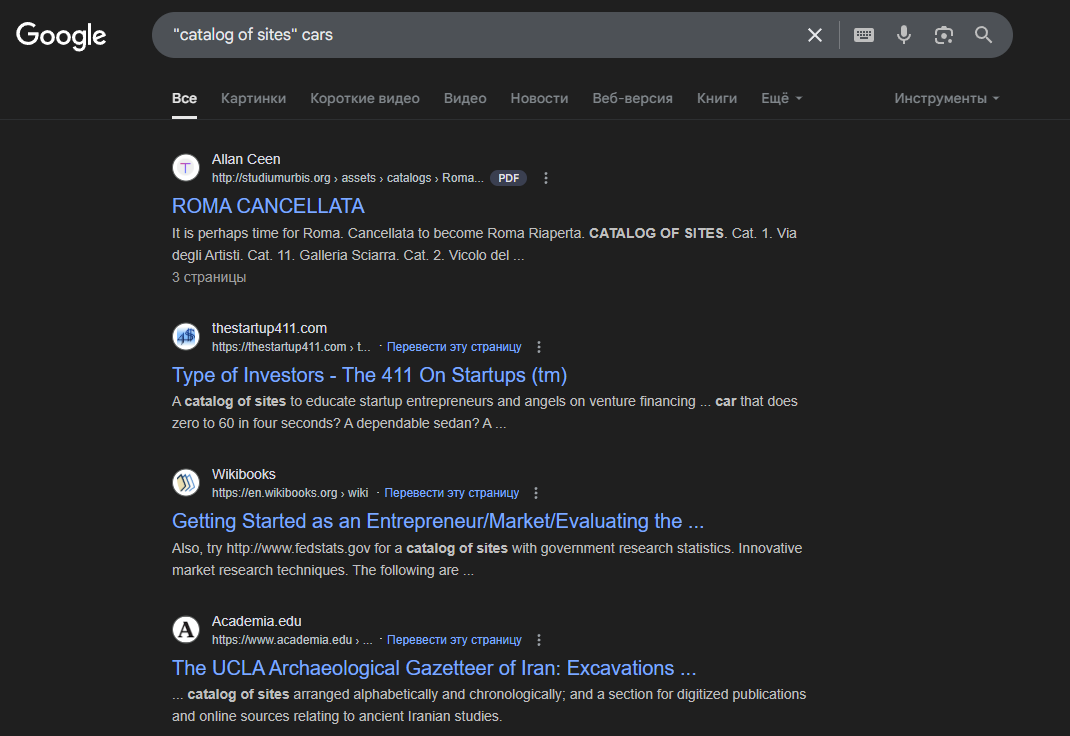
- Pitch your website: Once you've identified suitable pages, reach out to the website owner with a brief and personalized message. Explain why your site would be a valuable addition to their list.
- Earn the link: If your request is accepted, your website will be added as a trusted resource — typically with a dofollow link.
Tips for building links from resource pages:
- Focus on high-quality, authoritative websites with relevant and useful resource listings
- Write a personalized outreach message explaining your site's value to their audience
- If you don’t get a response initially, follow up once politely — but avoid spamming the site owner
Broken Link Building
Broken link building is a strategy where you find dead or non-functioning links on reputable websites and suggest your own content as a replacement.
This method is especially effective for earning dofollow backlinks because you’re helping site owners improve their content by fixing broken links.
How broken link building works:
- Identify broken links: Use tools like Ahrefs, Semrush, Screaming Frog, or the Chrome extension "Check My Links" to discover broken outbound links on relevant, high-authority websites in your niche.
Example using Semrush:- Go to the “Backlink Analytics” section
- Enter a domain, then select “Indexed Pages” and filter by “Broken Pages”

- Create relevant content: Once you've found a broken link, ensure you have a suitable piece of high-quality content that can serve as a replacement.
- Reach out to the website owner: Send a polite email notifying them of the broken link and suggesting your content as a helpful alternative. If they agree, you’ll earn a dofollow backlink.
Tip: Always suggest content that’s truly relevant and valuable as a replacement — otherwise, the site owner has no incentive to make the update.
The Skyscraper Technique
The Skyscraper Technique, developed by Brian Dean of Backlinko, is a content-driven strategy for acquiring dofollow backlinks. The idea is to identify well-performing content in your niche, create a better version of it, and reach out to websites that have already linked to the original source — encouraging them to link to your improved version instead.
Here’s how to apply this method effectively:
- Find popular content: Use tools like BuzzSumo or Ahrefs to identify high-ranking, frequently linked-to content in your niche.
- Create something better: Improve on the original by adding depth, updating data, integrating visuals, or improving layout and readability.
- Promote your content: Once your enhanced piece is live, contact websites that linked to the original and pitch your version as a more valuable resource.
Internal Linking
One of the key advantages of internal linking is that you control it entirely — allowing you to create relevant dofollow links across your own website. It improves user experience and boosts search rankings by distributing link equity across important pages.
By default, internal links are dofollow unless specified otherwise. This means they pass authority from one page to another and help Google better understand the structure of your website.
A well-planned internal linking structure serves several crucial functions:
- Link equity distribution — directs PageRank from strong pages to key commercial or conversion-focused pages
- Improved indexation — helps search engine crawlers discover and index deeper pages more efficiently
- Longer session durations — keeps users browsing by guiding them to related content
- Lower bounce rates — encourages deeper site exploration through relevant links
How to earn valuable dofollow links through internal linking:
- Audit your internal links regularly — identify and fix broken links and orphan pages with no inbound internal links
- Avoid overlinking — every link should be relevant and genuinely useful to the user
- Structure menus and sidebars — feature links to your most important pages
- Use contextual in-text links — these are more natural and carry stronger SEO weight
- Create deep links — connect not just to the homepage, but also to deep content within your site
- Optimize breadcrumbs — these automatically create dofollow links and improve both navigation and SEO
Track the performance of your internal linking strategy with the following metrics:
- PageRank (or equivalent authority metrics) distribution across your pages
- Average page depth during user sessions
- Average session duration
- Bounce rate reductions
- Ranking improvements of target pages
- Crawl depth and indexation speed of new content
Example of internal linking on the LinkBuilder.com blog: What is Outreach?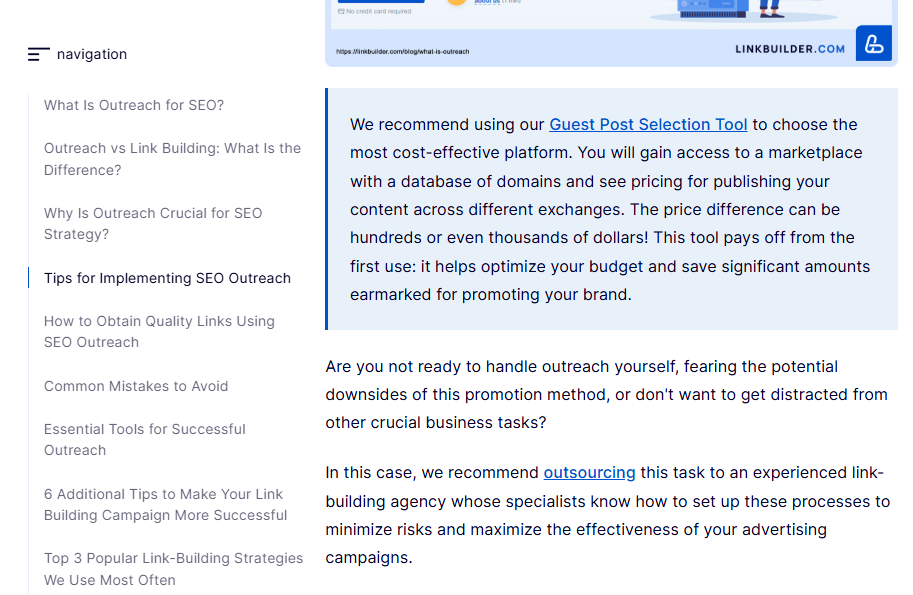
Proper use of dofollow links is a key part of any successful link-building strategy. By investing in a strong backlink profile, you enhance your domain authority, visibility, and competitive strength in search results. Regular monitoring helps you refine your approach and maximize link value.
Master these techniques and you’ll become a dofollow link-building expert — equipped to take your digital presence to the next level. And if you're looking for tools and services to support your efforts, the platform LinkBuilder.com is here to help you grow your site through smart, effective SEO.
LinkBuilder.com — the Best Platform for Getting High-Quality Dofollow Links
If you're still wondering where to get high-quality dofollow backlinks — LinkBuilder.com is exactly what you need! The platform offers placement of various types of links:
- Crowd links: Links placed on forums and in user comments, creating natural mentions of your site.
- Manual submits: Link placements in niche directories, classified ad boards, and online catalogs to improve site indexing in search engines.
- Niche inserts: Backlinks embedded into authoritative, niche-relevant articles and blogs already indexed by search engines.
- Profile links: Links with brand mentions placed in personal accounts or profiles on forums, social networks, or niche platforms to increase link mass and boost visibility.
- Contextual links: These are links embedded into relevant text that enhance its meaning and provide additional information on the topic. Used to attract a targeted audience to your site.
- Guest posts and outreach: Guest posting is the publication of articles on external, relevant, and authoritative websites to increase backlinks and attract their audiences to your site. Outreach is the process of actively contacting potential partners, bloggers, media outlets, or other resources to gain links, mentions, or collaborations that support brand promotion and improve SEO rankings.
If you’re interested in crowd links or submit links, you can independently configure the optimal ratio of dofollow to nofollow links on our platform, instantly view pricing, and place your order.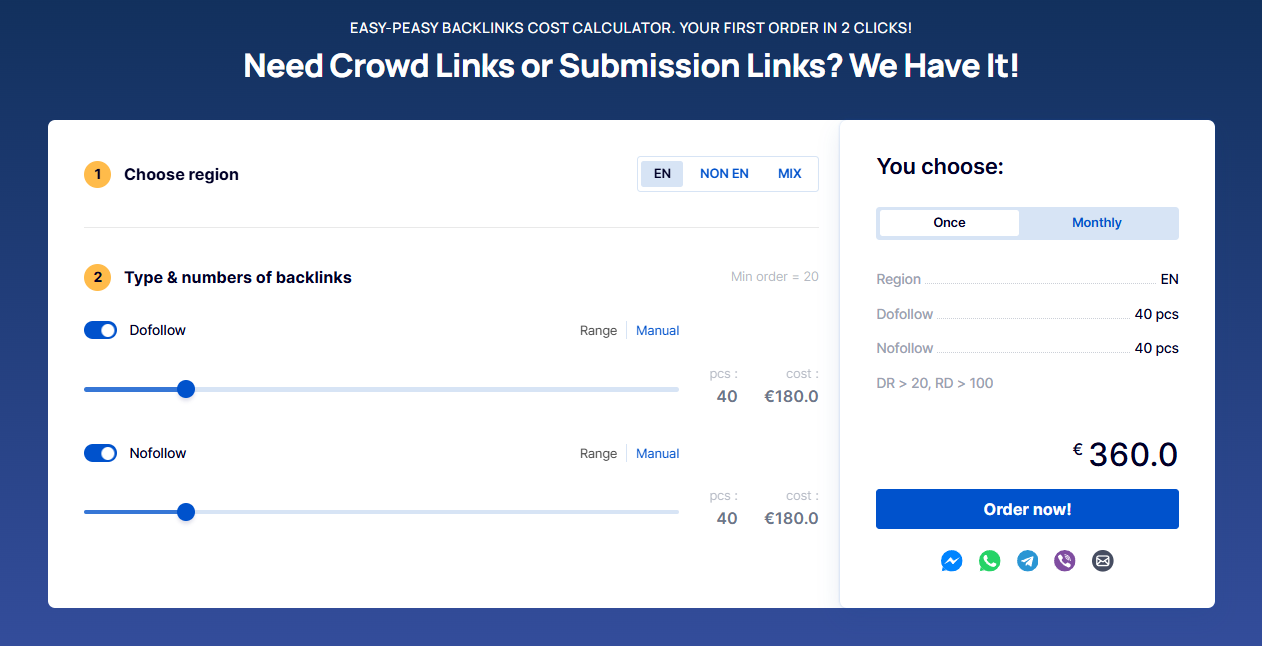
LinkBuilder.com is the ideal assistant for getting high-quality dofollow backlinks. To order links, you can:
- Contact a specialist via live chat, where you’ll receive advice and assistance with your link acquisition strategy.
- Use our backlink donor selection tool, giving you access to an extensive database of guest post sites. You can compare prices across websites and link marketplaces and purchase the backlinks you need.
Additionally, with a subscription, you’ll gain access to a free backlink database (crowd and submit links).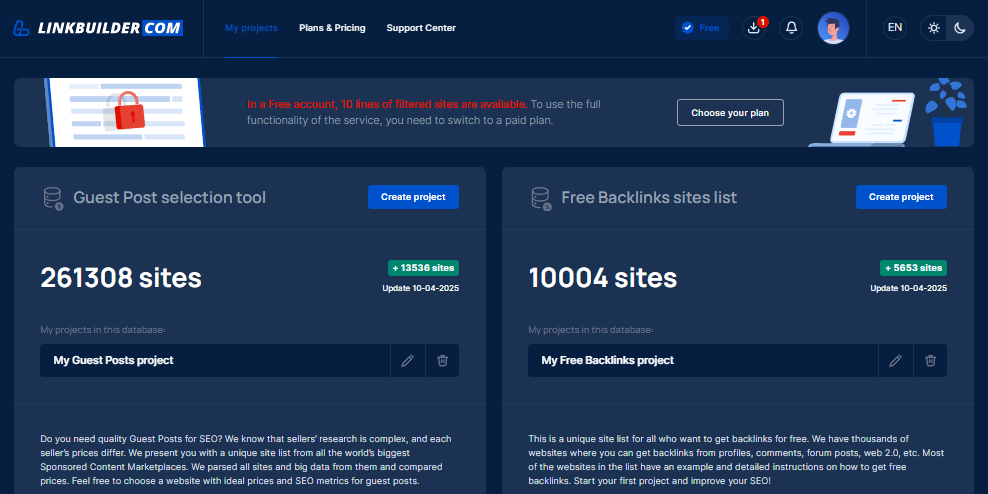
- Try our new free tool — the Guest Post Scanner. It lets you check guest post prices on almost any site. Especially useful for competitor analysis.
- If you already have data on your competitors’ backlinks — upload them to our SEO calculator and build your personalized link-building strategy. Use the SEO promotion cost calculator available on LinkBuilder.com.
Benefits of Working with LinkBuilder.com
- Large backlink posting database
LinkBuilder.com provides advanced link-building tools, offering a wide variety of platforms for placing crowd links, submits, guest posts, blog posts, social media, microblogs, directories, and media outlets. The database includes a vast collection of 300k+ platforms. A key advantage is the optimal balance between dofollow and nofollow links, ensuring a natural link profile. - Convenient user dashboard
The user dashboard is designed for maximum ease of managing your link-building strategy. A multi-level filter system allows you to quickly find optimal platforms based on your criteria, group them by relevant parameters, create personalized selections, and export data for further analysis. Transparent processes and full control over placements make using the platform efficient and user-friendly. - Innovative marketplace model
LinkBuilder.com offers the opportunity to save up to 70% on permanent guest post links. It has implemented an innovative aggregator model that brings together offers from various marketplaces and individual sellers on a single platform. This allows users to comprehensively analyze available options and select the most profitable deals without needing to register on multiple platforms — greatly streamlining the link acquisition process. - Competitive pricing model
The platform stands out with its attractive pricing system, providing access to high-quality backlinks with strong DR metrics. The pricing structure is organized into specialized packages tailored to different business segments and marketing goals.
A flexible order system with a minimum of just one backlink makes the service accessible to businesses of any scale. A team of SEO professionals ensures expert consultation and personalized support.
LinkBuilder.com is a leading company offering premium solutions for acquiring high-quality dofollow links, making it the ideal choice for SEO professionals. With its extensive site database and transparent selection system, LinkBuilder.com allows you to precisely tailor your link-building strategy to meet your business goals.
The platform provides unique opportunities for selecting and optimizing the dofollow/nofollow link balance, ensuring gradual and safe growth. Expert support and a personalized approach to each client guarantee excellent results — whether you're aiming to increase traffic or improve search engine rankings.
With LinkBuilder.com, you can be confident you're getting high-quality, effective dofollow backlinks that will drive long-term success for your business in the digital space.








